
Scaly Gondwana
Reptiles and amphibians,
the original Gondwanans
R eptiles, and their cousins, the amphibians, were the primary land-dwelling animals during the age when the Gondwanan fragments were still joined. That fact alone made them of interest to me. Additionally, like other classes that evolved early, before Gondwana had even separated from Pangea, the various orders within the larger class are present on all of the modern land masses, making observations fairly frequent and easy. While most people would not list reptiles as their favorite type of animal, and though fictionally exaggerated versions have been made into the villains of numerous bad movies, there are many exceptionally beautiful species within the class, especially along the Tour's route, where there were many more than I had anticipated. Here is a selection of the most interesting and impressive examples I saw throughout the Tour.
Unchanged For Millions of Years
The order Crocodilia contains perhaps the most imposing reptiles living today, thanks to their often-large size and predatory nature. Today, with the exceptions of the American Alligator, found in the extreme southeastern USA, and a portion of the range of the American Crocodile, which reaches into Central America, as well as that of that Saltwater Crocodile, which includes Southeast Asia, the members of the order live entirely on Gondwanan fragments. This implies that their evolutionary origins took place on the supercontinent, which are believed to have begun during the Triassic era. After an early start, however, evolution of the line, at least in terms of body form, slowed during the Cretaceous period, and the modern examples are not significantly different than those living at that time. This is generally believed to signify the attainment of a very successful physical form, which has allowed the Crocodiles to survive many subsequent changes in global climatic conditions.
I was actually a little surprised at how many examples of the order I saw during the Tour, however, most of those occurred in protected areas and not in the types of places frequented by touring cyclists. Perhaps that was a good thing. The most numerous sightings were the Jacare Caimans in the Pantanal of Brazil. When I visited there, during the dry season, their numbers lying about around the rapidly-shrinking ponds of that great wetland were very impressive. That may have caused a little anxiety, were it not for their generally overfed nature, caused by the buffet of distressed fish that had been presented to them. One species that I didn't see was Africa's Nile Crocodile, and given their famous proficiency at hunting big game, that may have been a good thing too.
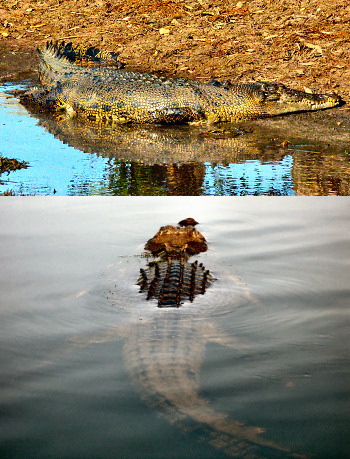
Saltwater Crocodiles in Australia's Kakadu National Park
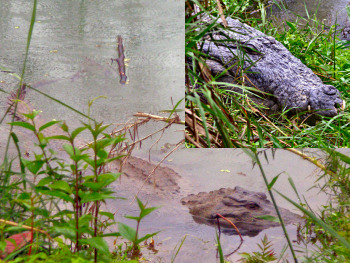
Mugger Crocodile in Nepal's Royal Chitwan National Park
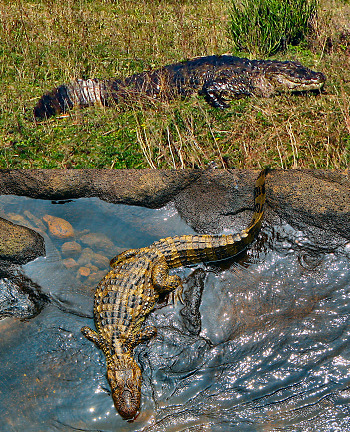
Broad-Snouted Caiman in Brazil's Lago Miriam Wildlide Refuge, and
Argentina's Parque Nacional Iguazu
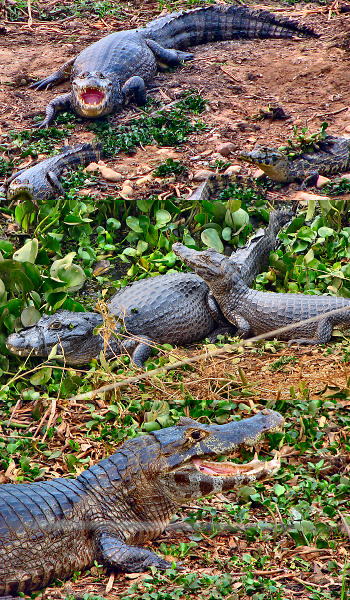
Jacare Caimen in Brazil's Pantanal
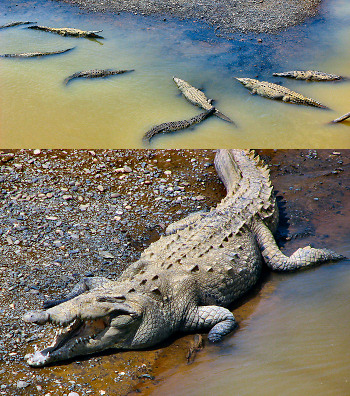
American Crocodiles in Costa Rica's Rio Tarcoles
Legless Wonders
Snakes are another type of reptile that elicits squeamish behavior from many people. However, as with the other reptiles, there are many beautiful examples of snakes, and they should primarily be appreciated, as the threat they pose is most often greatly exaggerated. Most snakes are far too small to hunt anything even approaching the size of an adult human, and we, as we are often reminded, are more of a threat to a snake than the snake is to us. Indeed, being stepped on by a 90-kg human, such as me, would certainly be bad news for most snakes. One common activity where I might have accidentally done that during the Tour was walking through the bush in the evening searching for a campsite. When doing so, I paid particular attention to my footfalls, and always tried to push the front wheel of the bike a meter ahead of my feet to provide ample warning, or at least an alternative target, for any lurking snakes. That must have worked, since I never saw a single snake under those circumstances. In fact, I saw disappointingly few snakes in any case during the Tour. Those that I did see were most often risking their own lives by crossing a busy highway.
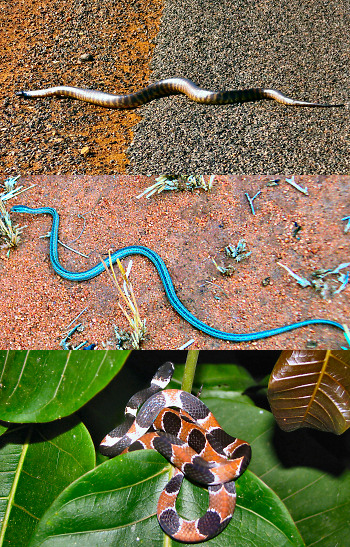
A few harmless snakes seen in (Top Down): Australia; Madagascar; Peru
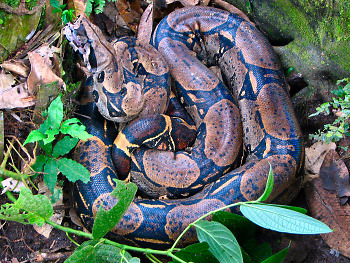
A large Boa Constrictor in the Peruvian Amazon
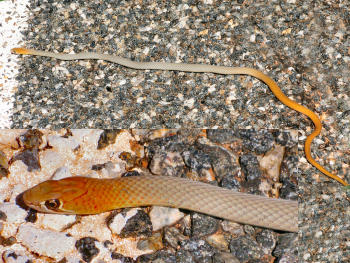
A venomous Yellow-Faced Whip Snake in Australia
Of course, mine would not have been a typical visit to India had I not seen one of their famous "snake charmers." However, like most such forms of "entertainment" the show is more of act than any sort of actual charming of the snake, which seems to derive little benefit from its participation. Though, I suppose, as far as animal acts go, the snakes are relatively well treated.
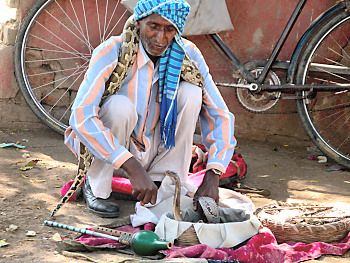
A Snake Charmer in Agra, India, with a Python and Cobras
Creaking Amphibians
Though they don't possess true scales, amphibians, nonetheless, share many features with reptiles. However, their partially aquatic life makes them a little more difficult to observe, especially when on a bike tour. Indeed, Frogs are more often heard than seen, and salamanders, toads, and the very bizarre caecilians usually require quite an effort to observe. Add to that the saddening, and still poorly understood, declines in worldwide amphibian populations linked to environmental changes, and I was lucky to see many at all. The three frogs shown below are all species found in rainforests, where seeing interesting examples is a little easier.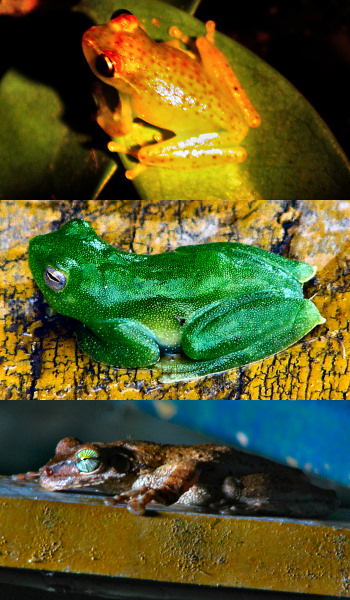
Frogs seen in (Top Down): Madagascar; Peru; Peru
The Sturdy Ones
Tortoises and Turtles are a family of reptiles that I find quite appealing. With their characteristic shells, few types of animals can compare. However, their rather inconspicuous appearances, along with their legendary slowness, make them easy to miss, especially when cycling. On the other hand, once they are spotted, those same factors allow one to easily approach and get a really close look. Therefore, most of my sightings during the Tour were of small Tortoises along the roadside, including the Madagascar Radiated Tortoise and Argentine Tortoise, shown below, with much fewer observations of the more difficult-to-see riparian-zone Turtles.
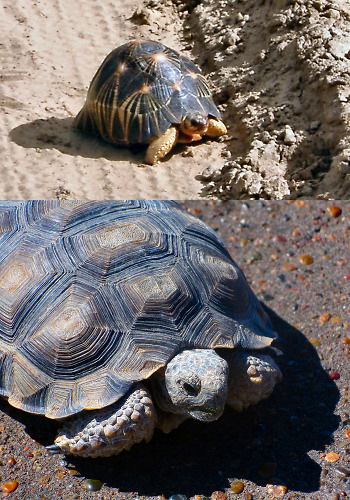
Tortoises in the road in: Madagascar (Top); Argentina (Bottom)
One type of place where it is possible to see the most impressive examples of the family is on islands, where gigantism has evolved on more than one occasion. While large, slow Tortoises may have difficulty surviving on continental landmasses, where they are vulnerable to many other types of creatures, especially those that would eat or damage their eggs, on islands, where such factors may be absent, they have better chances and may grow to tremendous sizes. I saw that for myself when I visited the renowned Islas Galapagos, famous for their Giant Tortoises, as well as other endemic creatures. While there are different species for many of the different islands of the archipelago, I only saw them in the wild on Isla Santa Cruz. However, while many people only observe them at the breeding centers, or on private ranches, I was quite pleased that I also saw them independently, while cycling through the island's Giant Tortoise Reserve.
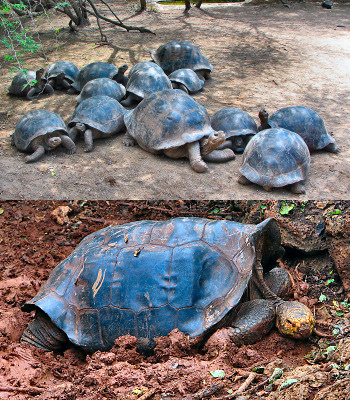
Juvenile Tortoises at the Isabela Breeding Center, Islas Galapagos (Top);
An Espanola Giant Tortoise at the
Charles Darwin Breeding Center, Puerto Ayora (Bottom)
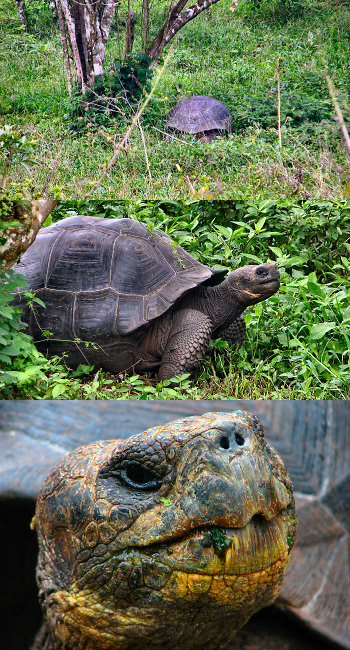
Wild Tortoises in the Santa Cruz Tortoise Reserve; Islas Galapagos
Masterworks of Evolution
Certainly the most distinctive, and possibly my favorite, reptiles are the Chameleons. Half of their species are endemic to Madagascar and most of the rest live nearby in Africa, though there are some species in other parts of the world. My encounters have mostly come on the big island, with one or two on the African mainland. Without a doubt, most Chameleons are perfectly adapted to a life in the trees. Their prehensile tail, independently movable eyes, swaying gait, flattened torso, greatly extendable tongues, and their famous chromatomorphic skin all help them hunt for insects among the branches. However, not all are tree dwellers. The smallest family, the Brooksian Chameleons, live mainly on the forest floor, where their small size and brown, textured body help them blend into the leaf litter. I would never have seen any of these when I was in the rainforests of eastern Madagascar were it not for the expert eyes of my local park guides, which made me glad that their services were required.
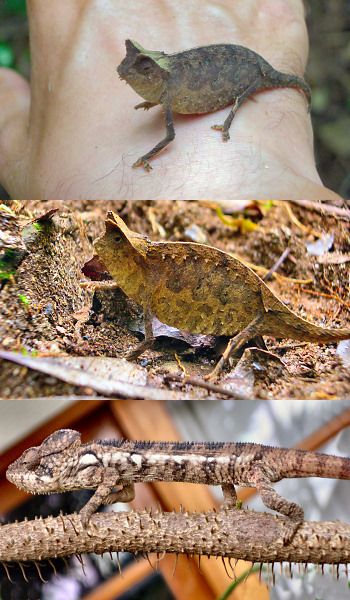
A Small Brooksian Chameleon (Top, Middle) and a Chameleon
mimicing a branch (Bottom)
It is a modern legend that Chameleons instantly change color to match the appearance of the surfaces on which they stand. While they certainly can change their appearance for camouflage, as seen in the top panel below, most of their colorations are used for communications, or to convey simple emotions. This is verified by the two lower images below, where two Chameleons have made no attempts to match the appearnce of the dusty roads surface over which they were slowly walking.
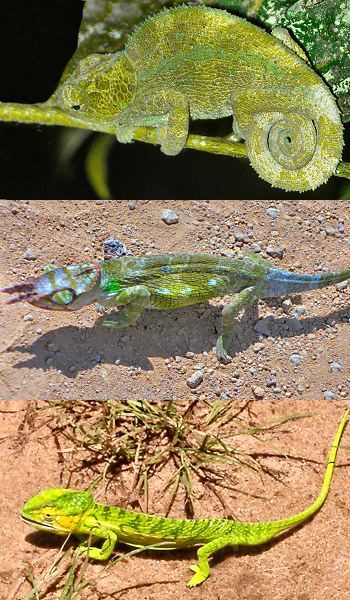
A few colorful Chameleons seen in (Top Down): Eastern Madagascar;
Tanzania; Western Madagascar
Lizards, Skinks & Geckos
The most frequently seen reptiles along my tour route were the common members of the suborder Lacertilia, of the order Squamata, the Lizards, Skinks, and Geckos. Of those, by far the most numerous were any of the numerous basic grey or grey-brown lizards, as seen below. While they are usually fleet of foot, and a little nervous, I was often able to observe them closely without too much difficulty. By doing so, I cannot say that I found any major differences among the types I saw in various parts of the world, as should be apparent in the images below. However, that is not the whole story for this order.
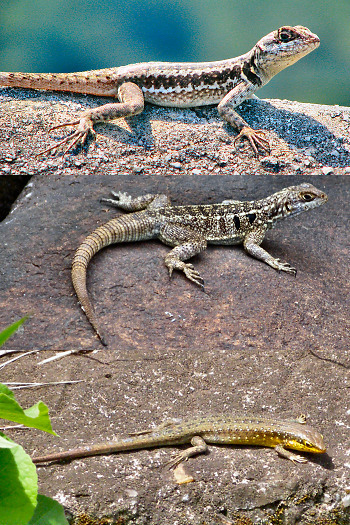
Plain Lizards & Skink seen in (Top Down): Brazil; Madagascar; Rwanda
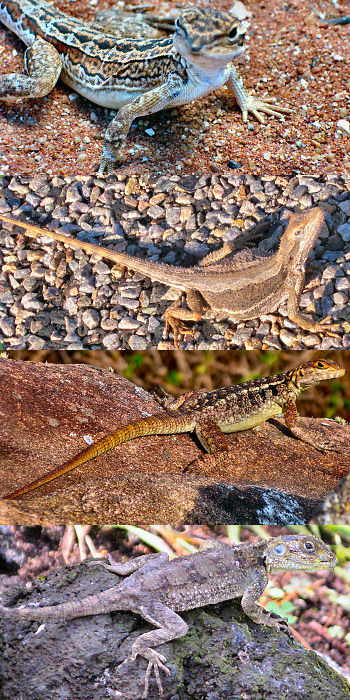
Plain Lizards seen in (Top Down):
Australia; Australia; Madagascar; Rwanda
Occasionally one comes across an example that takes distinctiveness to a new level. One such case would be the Thorny Devil Lizard of west-central Australia. These fearsome-looking, but small and timid residents of the Outback are only very distantly related to the American Horned Lizards. The prehistoric appearance of the one I saw certainly provided a bit of variety to an otherwise tedious day on the lonely highways of Western Australia. Another lizard that was far from plain and grey, was the little creature seen in the lower panel below, whose body camouflage allowed it to blend in perfectly with the leaf litter on the floor of the Peruvian Amazon basin.
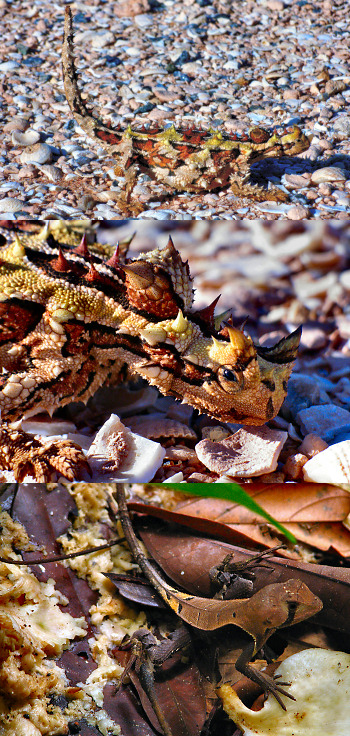
A Horned Lizard in Western Australia (Top, Middle);
and a leaf-mimicing lizard in the Peruvian Amazon (Bottom)
On the Islas Galapagos, a small lizard, the Lava Lizard inhabits most of the major islands of the archipelago. There are now a few distinct species existing on some of the more isolated island, however, the lizards found on the major islands are considered to be a single species. Differences in coloration can be seen in the images below, and it may be that evolution is already causing divergence into new species for the different islands.
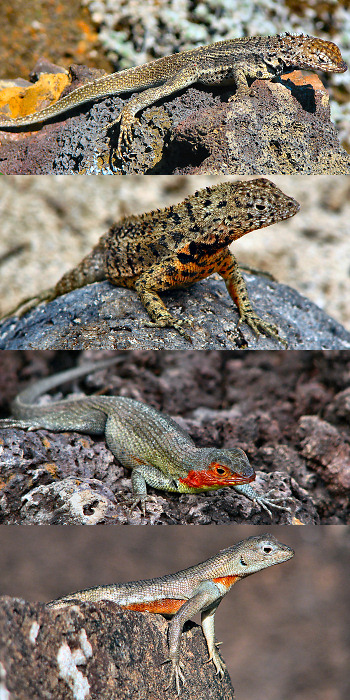
Lava Lizards of the Islas Galapagos seen on (Top Down):
Isla Bartolome; Isla Santa Fe; Isla Santa Cruz; Isla San Cristobal
The Color Blue
I had been familiar with grey lizards, as well as green lizards, before the Tour, and though I knew that there would be more variation in colors seen in other parts of the world, I had certainly not expected to see the color blue so well represented among the species I saw. Some had only a little blue, like the tongue of the Blue-Tongued Skink, shown in the top panel and inset of the image below, which I saw in the Northern Territory of Australia. Blue heads and tails were also seen more often than I would have expected, and can be assumed to play a role in courtship behaviors. That aspect was most strikingly seen in the male Agama Lizard seen in Serengeti National Park, in Tanzania. The females of the species living amongst the rocky outcrops above the plains were much more plainly colored and were being courted by their bright pink and blue suitor. Interestingly, the male lizard is only colored in such a way during the day, at night he turns dark brown.
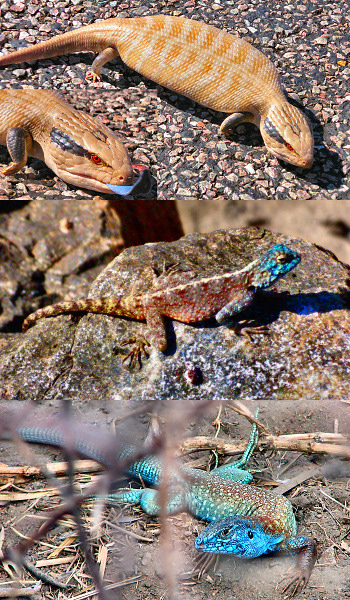
Skink & Lizards with Blue coloration seen in (Top Down):
Northern Australia; Lesotho; Peru
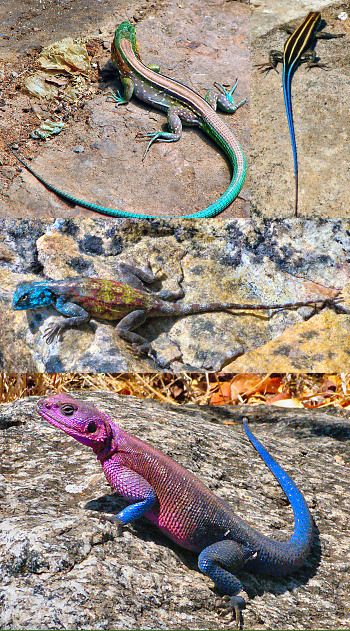
Lizards with Blue coloration seen in: Peru (Top-Left);
Malawi (Top-Right); South Africa (Middle);Tanzania (Bottom)
The Complete Spectrum
Occasionally, colors are taken even further. The examples below show some of the variety that exists in the Reptile line. The culmination may be the Day Geckos of the genus Phelsuma found mainly in Madagascar and the islands of the Indian Ocean. Like most Geckos, they walk up and down walls and across ceilings, and in so doing make themselves excellent photography subjects.
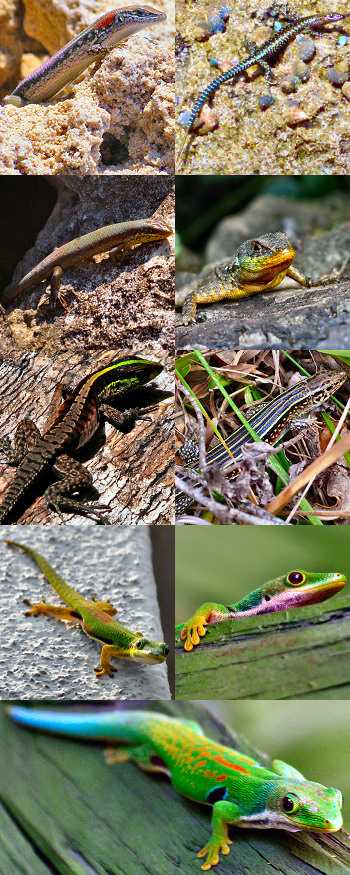
Colorful Lizards in: Rwanda | Madagascar Row 1
Peru | Argentina Row 2
Madagascar | Madagascar Row 3
Gecko in: Madagascar | Madagascar Row 4
Madagascar Row 5
Modern Day Dragons
Certainly the reptiles of the Jurassic and
Cretaceous periods can claim the prize as the largest such creatures of all time. However, today there are still some examples that grow to at least a mildly fearsome size. The Iguanas of tropical South and Central America can grow to a somewhat impressive size, though their rather clumsy, dim-witted nature does little to create anxiety. A few other lizards I saw, including the Tegus of South America, were rather hefty creatures, but also less than intimidating. Perhaps fortunately, I did not get close enough to the Indonesian island of Komodo to attempt to visit its shores and see the giant, and deadly, Komodo Dragons that inhabit that small island. Instead the largest lizard I saw, shown in the bottom panel, was the two-and-a-half-meter long Water Monitor Lizard that sauntered across my path in Sri Lanka. All Monitors are carnivorous, but the Water Monitor, unlike its larger relative on Komodo, does not feed on humans. It was the closest thing I saw to a dragon during the Tour, however. I don't know if I am disappointed about that, or not.
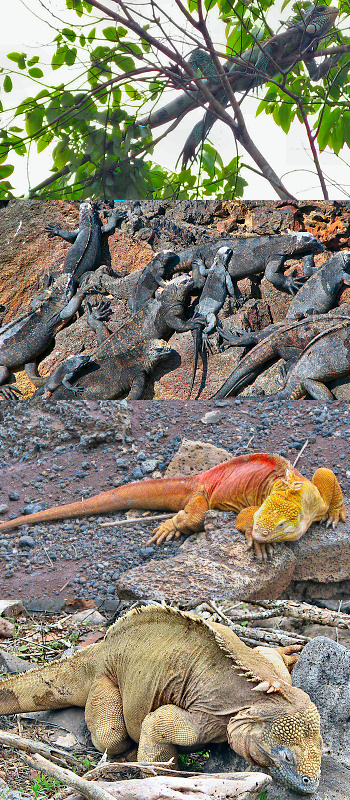
Iguanas seen in (Top Down): Peruvian Amazon;
Isla Isabela (Galapagos); Isla Santa Cruz (Galapagos);
Isla Santa Fe(Galapagos)
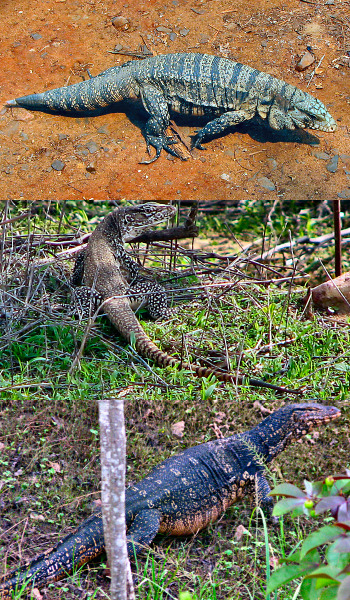
Very large Lizards seen in (Top Down): Argentina; Peru; Sri Lanka
Previous | Next
Main Index | Pre-Tour Index
Post-Tour Index | Articles Index
Slideshows
Main Index Pre-Tour Post-Tour Articles Previous Next |
Dangerous
Creatures?
Talk of Reptiles frequently brings up uneasy feelings within many people, including several members of my family. I have always preferred to treat wildlife with respect and with an understanding of their capabilities and behaviors, instead of fear. Certainly there are Reptiles in the World which can seriously injure, or kill, an adult human being. However, there is little reason for one to put themselves in a position to be harmed in such a manner. During the Tour, I did not experience even a "close call" despite spending a fair amount of time in Reptile-infested bush.
One possible occurrence took place in coastal Queensland, Australia. Late in one evening I was having a bit of difficulty finding a suitable place to camp for the night. Eventually, I settled upon a thick patch of woods along the roadside. Normally, I would walk as far away from the road as possible, but in that case the woods were very thick and the ground soon began to slope downwards which, combined with the encroaching darkness of nightfall, prevented me from seeing anything further on, not to mention moving forward. A little later, as I was trying to get to sleep, something fairly large started rustling around in the surrounding bushes, moving fairly slowly and deliberately. I assumed that it was probably a wombat, or a possum, and eventually just fell asleep. The following morning, when I returned to the road it soon turned in the direction I had walked that night, and crossed a fairly large river. On the bridge was a sign marked "Danger: Crocodiles". I am still not sure if the animal outside my tent was a croc, or something else, but since I left it to its own business it left me to mine. In any case, the likelihood that a croc would decide to try to eat an inanimate object as large as my tent, many times the size of its normal prey, seemed rather remote.
Also in Australia, I was aware of the perception that a large percentage of the World's most venomous snakes live on that continent. In reality, that idea is more a case of pop-cultural exaggeration than any type of useful information. To be sure, there are many snakes in Australia whose venom is very toxic. However, a number of those are small snakes which prey on creatures the size of mice, and which would only bite something as large as a human if they were in imminent danger themselves. Of the four snakes I saw in Australia, only one was venomous, the Yellow-Faced Whip Snake, pictured on this page, and that hardly seemed like a Reptile that should inspire much concern.
In fact, after cycling on five continents I can say, with a little credibility, that the type of animal mostly likely to cause harm to a respectful touring cyclist is: Bees.